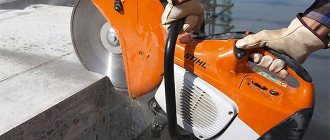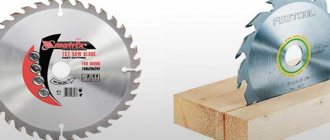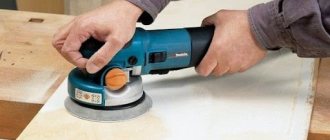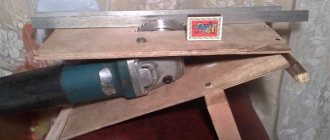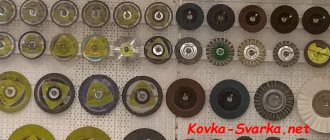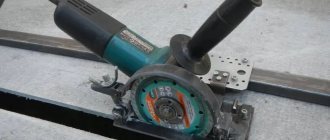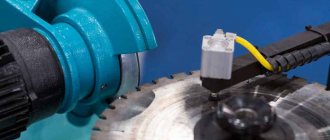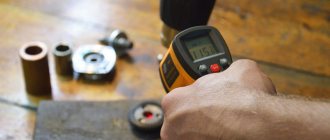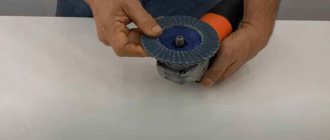What a “grinder” is nowadays, even a schoolchild knows, is an angle grinder designed for working with metal workpieces using special cutting and grinding wheels. Not everyone, but only professionals, know that such an electric tool can be used for processing wood, so this article is intended to fill this gap in the information available to ordinary users. Disc for an angle grinder for wood - types, general characteristics and standard sizes, as well as safety measures for use and a review of prices for popular models - this is the topic of this article by the editors of HomeMyHome.ru
Depending on the type of discs used, the “grinder” in skillful hands can be used at various stages of working with wooden workpieces: from sawing to grinding
Is the angle grinder designed for working with wood?
The “grinder” was not originally intended for sawing wood, especially for workpieces of considerable thickness and hardwood. This is due to the design features of this type of tool and the associated dangers of use:
- when the saw blade jams, it is difficult to hold the angle grinder in your hands, which can lead to injury;
Important! Jamming of the saw blade when using an angle grinder to cut wooden workpieces is the most common problem with this type of work, which is due to the softness and viscosity of the wood.
- Inhomogeneity of the wood structure due to the presence of knots can lead to damage to the saw blade being used and injury to the user.
Using special circles and following safety rules, the likelihood of injury can be reduced to zero, even when sawing lumber products.
Despite the potential danger of using angle grinders as a tool for sawing wooden products, manufacturers of consumables, which include grinder discs, produce similar products .
Expert's point of view
Victor Isakin
Tool selection specialist for the 220 Volt retail chain
Ask a Question
“For processing workpieces of considerable thickness and for professional use, it is most correct to use a tool originally intended for sawing wood, such as a circular saw and a circular saw.”
The main and most common uses of grinders when working with wood are: stripping, grinding and polishing, for which manufacturers produce special types of discs.
How to choose the grit of a sanding wheel for wood
September 04, 2022
Anatomy of an Sandpaper Sandpaper or sanding wheel consists of three main components: the abrasive, the backing material and the binder.
What is a grinding wheel? A grinding wheel is an abrasive cutting tool. It can be used for manual surface processing or for use on machines or special grinding devices. For example, professionals demand a grinding wheel for a sharpener with a grain size that will ensure the most efficient use of the tool.
Grinding wheels are classified according to many parameters. The presence of abrasive materials and binding elements is mandatory for each type.
The grains of the abrasive material can be made of:
- silicon carbide;
- diamond (artificial or natural);
- electrocorundum;
- elbora.
It is the grain size of grinding wheels that determines their main functional purpose. An abrasive cuts microscopic chips from parts or material. As for the ligament, it can be of artificial or natural origin. The purpose of the binder is to firmly hold the grains together.
In addition, there are necessarily pores on the surface of the grinding wheel. Due to the space not filled by the ligament - microscopic pores - roughness is formed on the surface. Some manufacturers provide grinding wheels with specific impregnations to reduce the temperature in the processing area. Such instruments are called “impregnated”.
Abrasive material is a substance ground to fine grains. To produce sandpaper, various types of abrasives are used: aluminum oxide (electrocorundum), silicon carbide, garnet, glass, CBN, etc. The size of the abrasive particles determines the most important characteristic of the sanding paper - its grain size, which we will talk about in more detail.
The backing is a paper or fabric base onto which the abrasive material is glued. The fabric is more often used for belts, rolls and some types of sanding discs. Paper is commonly used for sanding sheets and most types of discs. Along with paper and fabric substrates, you can find options made from polyester materials.
Binder is a layer of adhesive that holds abrasive grains. Hide glue, synthetic resin (a more durable option), or a combination of these two materials are used as a binder.
Let's understand the types of coatings For various works with wood: rough processing, preparation for applying finishing, interlayer sanding of coatings, polishing, etc., the following types of abrasives are traditionally used.
Aluminum oxide (electrocorundum) . It is characterized by high density and resistance to crushing. The most common abrasive for sanding wood and metal. Recommended for sanding untreated wood.
Silicon carbide . During operation, the crystals of this abrasive split, forming new cutting edges. This feature of the grains ensures the self-sharpening of the skin and prevents it from quickly clogging. Sandpaper coated with silicon carbide is recommended for delicate sanding, for example, interlayer sanding of finishing coatings.
Pomegranate . Relatively soft mineral abrasive. It has the ability to self-sharpen, but wears out quickly. Traditionally it is used for finishing sanding of treated and untreated wood.
Aluminum ceramics . This is aluminum oxide that has undergone additional high-temperature treatment. Its abrasive properties are higher than those of its unfired counterpart. It is characterized by maximum wear resistance and is optimal for processing wood at various stages.
How not to make a mistake with grain size? Grit is the most important characteristic of sanding paper. When the hackneyed question comes up: what sandpaper to sand wood with, they usually mean not so much the type of coating, the nature of the binder, etc., but rather the grain size.
The suitability of sandpaper for a particular type of work depends on the gradation of grain size. At first glance, everything seems simple, but in practice, choosing the right skin is often complicated by confusion in labeling by numbers.
It so happens that there are several sandpaper standards in active use on the modern market: the international classification ISO 6344 (the new Russian GOST R 52381-2005 fully complies with it), the old Soviet marking (GOST 3647-80) and the American standard (CAMI).
TABLE: TYPES OF SANDYPAPER GRAINS, PURPOSE OF ABRASIVE, RATIO OF MARKINGS
| Purpose of abrasive | Marking according to ISO-6344 (GOST R 52381-2005) | Marking according to GOST 3647-80 (Soviet standard) | Marking according to CAMI (American standard) | Grain size, microns |
| Coarse abrasives | ||||
| Rough wood processing | P40 | 40-N | 40 | 400-500 |
| P46 | 32-N | 50 | 315-400 | |
| P60 | 25-N | 60 | 250-315 | |
| Primary sanding Leveling the wooden surface | P80 | 20-N | 200-250 | |
| P90 | 16-N | 80 | 160-200 | |
| P100 | 12-N | 100 | 125-160 | |
| P120 | 10-N | 120 | 100-125 | |
| Preparing hard wood for finishing Final sanding of soft rocks Sanding old paint for painting | P150 | 8-H | 150 | 80-100 |
| P180 | 6-H | 220 | 63-80 | |
| Fine abrasives | ||||
| Finish sanding of hardwood Sanding between coats | P240 | 5-N, M63 | 240 | 50-63 |
| P280 | 4-N, M50 | 40-50 | ||
| Final sanding of the finishing coating Polishing | P400 | M40/N-3 | 28-40 | |
| P600 | M28/H-2 | 360 | 20-28 | |
| Ultra-fine sanding Removing micro-scratches | P1000 | M20/H-1 | 600 | 14-20 |
What is open and closed abrasive loading? Based on the characteristics of the application of abrasive material, sandpapers with open and closed filling are distinguished. This is another important parameter that you should pay attention to when choosing sandpaper for working with wood.
In open and semi-open sandpaper, abrasive grains cover from 40 to 60% of the working surface. The sparse filling of grains prevents the abrasive from quickly clogging with wood chips, resin, paint and other waste. This sandpaper is optimal for machine sanding, processing wood for painting, and working with soft and resinous woods.
In closed- or solid-fill sandpaper, the abrasive grains cover the entire working surface. This type of sandpaper is more effective for manual sanding, working with hard wood, and finishing polishing.
How to extend the life of an abrasive? As the abrasive grains become clogged with chips and wood resin, the sandpaper loses its working properties. A clogged abrasive, especially when machine sanding, leaves dark marks, compresses the fibers and polishes the surface, which is why the wood does not absorb the finishing compound well.
To make abrasives last longer, start with a coarser sandpaper and gradually move to finer-grain paper. For soft and resinous woods, use sanding paper with a sparse coating and a special stearate coating (a dry lubricant that prevents rapid clogging of the abrasive).
When working with a sander, take your time. Overheating the surface leads to softening of the binder and accelerates wear of the abrasive grains. An important factor is the storage conditions of the grinding material. Cold and critical humidity can render it unusable. The optimal storage temperature is 15-25°C with a relative air humidity of 35-50%.
How to clean sandpaper from wood dust? Traditionally, a special cleaning bar made of natural rubber is used to clean clogged abrasives.
A piece of garden hose or, no matter how ridiculous it may seem, a worn-out sneaker can cope with this task no less successfully.
All of the above cleaning methods are more relevant for grinding machine abrasives. To clean regular sandpaper, you can use a brush with stiff plastic bristles.
General characteristics of discs for grinders, depending on the type
Discs designed for different types of use vary in their design and the materials used in their manufacture. In this regard, different types of similar products have different general characteristics, which requires their separate consideration.
Circular disc for angle grinders for wood, 125 mm
Cut-off models
There are several types in this product category:
- circular saw blades – considered “dangerous” saw blades;
- chain - made using links intended for chain saws;
- with a small number of teeth - they are the safest compared to compass analogues;
- made of tungsten carbide - the safest type of such equipment.
The chain disk can be used for both sawing and roughing
For your information! Circular discs come in two modifications: a “dangerous” and a “less dangerous” option. A distinctive feature of models of the “less dangerous” type is the presence of protection against jamming, provided by the spread of the teeth.
Chain modifications are less dangerous when used, because Their design provides for a non-fixed fit of the saw chain on the surface of the disc.
Expert's point of view
Victor Isakin
Tool selection specialist for the 220 Volt retail chain
Ask a Question
“If the saw chain jams during use, the disk mounted on the angle grinder continues to rotate, the tool does not break out of the hands, allowing it to be stopped in an emergency.”
A disc with a small number of teeth cuts wood well both along and across the grain
Discs with a small number of teeth come in two types:
- with 3 teeth – used with small “grinders” with a diameter of up to 150 mm;
- with 4 teeth - used on large grinders with a diameter of 230 mm.
A distinctive feature of models made from tungsten carbide is the absence of teeth on the cutting surface of the product. The cutting element is the segments located around the circumference of the disk.
Important! Tungsten carbide models are capable of sawing various metal products (nails, screws, etc.) that may end up in the workpiece without damaging the cutting elements or their integrity.
Appearance of a tungsten carbide disc mounted on an angle grinder
Discs for roughing work
For stripping wooden products, manufacturers produce several types of attachments that differ in design and types of materials used in their manufacture.
A grinding disc with crumbs applied to its surface
By design, such nozzles can be made in the form of:
- a disk with spikes or crumbs applied to its surface;
- glasses with cutting elements made of twisted wire inserted around its circumference;
- disk with wire turns mounted on its surface.
Expert's point of view
Dmitry Kholodok
Technical director of repair and construction
Ask a Question
“Sanding attachments are used to remove paint and other coatings applied to a wood surface, as well as to rough the wood surface being leveled.”
Attachments for the “grinder”, which have twisted wire elements in their design
Grinding and polishing models
To perform grinding and polishing, there are special attachments used for both wood and other materials (metal, plastic, glass, etc.).
Set of polishing attachments for angle grinders (125mm) Bison model “3591-125-H7”
Nozzles used for such purposes are of two types:
- the basis of the design is a metal base fixed to the angle grinder shaft, and circles made from sandpaper of different grain sizes or polishing materials (felt, fabric, etc.), which, in turn, are attached to the base using Velcro;
- flap sanding wheel.
Flap sanding wheels are available in different grits, which allows you to choose the one you need for a specific type of processing.
Saw blades for angle grinders
Wood saw blades for angle grinders have been developed by various manufacturers and, as a result, come in several varieties. The simplest and, of course, the cheapest option is to install a round disk of a suitable size on the grinder, both in outer diameter and in diameter of the internal mounting hole. For an angle grinder, which in terms of its overall characteristics belongs to the small category, a circle of 125x22 mm is suitable.
grinder disc for wood
Technically, you can install a disk with a diameter of 230 mm on a small grinder, but to do this you need to remove the protective cover, which is completely unacceptable.
The angle grinder user's hands are very close to the rotating work surfaces, and any abnormal situation can cause serious injury.
The use of such a wheel on angle grinders may cause serious safety hazards and is strongly discouraged.
Another area of adaptation of circular saws for use on a grinding machine was to reduce the number of teeth.
Discs with a diameter of 115 mm or 125 mm have only three teeth; a disc for an angle grinder with a diameter of 230 mm can have 4 teeth. In this way, manufacturers tried to compensate for the high rotation speed of the saw blade.
grinder disc for wood
A completely new direction in the development of circular discs was marked by the invention of a special attachment suitable for working with various materials. This universal disc consists of a special composition - tungsten carbide . This saw blade has no teeth at all. This type of blade allows for good cutting of a wide variety of materials, and can be considered the safest blade for sawing wood among all those used on angle grinders.
Standard wheel sizes for grinders
When producing discs for angle grinders, the company's manufacturers operating in our country produce their products in accordance with the following regulatory documents:
- GOST 21963-2002 (ISO 603-15-99, ISO 603-16-99) “Cutting wheels. Technical conditions".
- GOST R 53410-2009 (ISO 603-12:1999-ISO 603-14:1999, ISO 15635:2001, ISO 13942:2000) “Grinding wheels for hand-held grinding machines. Technical conditions".
In accordance with these documents, the standard sizes of disks used on angle grinders are: 115, 125, 150, 180 and 230 mm.
For your information! The seat size for all standard sizes is 22.2 mm.
The use of angle grinders for grinding wooden products is quite widespread among users of different categories.
woodworking
On the domestic market of hand-held electric tools, discs for angle grinders from Russian and foreign companies are presented. Among them, the most popular are:
- "GRAFF" (Belarus);
- "GREATFLEX" (China);
- "Bosch" and "Klingspor" (Germany);
- “Ziflex”, “PRACTIKA”, “LUGA” and “ZUBR” (Russia);
- "Makita" and "Hitachi" (Japan);
- "FIT" (Canada).
In addition to the brands listed above, other manufacturing companies are also popular in different regions of our country, which is due to the location of the region and the presence of dealers of these companies in a particular territory.
Saw blade brand “Zubr” with outer diameter 235 mm
Safety precautions when working with a grinder on wood
When performing work on wood processing using an angle grinder, the safety measures are the same as when using metal and other materials. However, in connection with the physical properties of wood, which have already been written about above (softness and viscosity), it is necessary to take them into account, and in this regard:
- You cannot fix the “Start” button, because in this case, it will not be possible to quickly turn off the tool.
- Sawing workpieces must be performed at a strictly specified angle, without creating distortions that can cause the saw blade to jam.
- All work must be carried out with the protective cover installed and the use of personal protective equipment (gloves).
When performing grinding work, the use of respiratory protection is also necessary. - It is better not to use “dangerous” saw blades equipped with large teeth on large-sized “grinders”, because In the event of an emergency, it will be impossible to hold the tool in your hands.
- The presence of a speed controller on the tool is not a prerequisite for its use for such work, but it is desirable, because This will reduce the likelihood of injury if the saw blade jams.
Technique for sanding wood with an angle grinder
When starting to process wood with an angle grinder, you need to keep two main points in mind:
- You should not process the surface of the workpiece with the entire area of the grinding disc, as marks from the wheel may remain. Only the upper part of the nozzle is used.
- During sanding, the grinder is guided along the grain of the wood: this way there will be no marks left. At the same time, it is important to find a support point so that your hands do not get tired.
The general process of sanding wooden surfaces with a grinder is divided into several separate stages:
- Preliminary preparation of the coating. All remnants of the previous paint and varnish are removed with rough grinding wheels. It is also worth making sure that there are no nails or screws sticking out from the floor or wall, if they are the ones being sanded. Protruding fasteners must be removed, and if this is not possible, immersed as deeply as possible into the surface so that they do not in any way affect the operation of the angle grinder.
Pre-processing of the part
When sanding floors, there are two more mandatory rules. Even if only a small area of the floor is being processed with a grinder, it is recommended to remove all furniture from the room and cover doorways and windows with thick film or oilcloth to protect from dust. Any cracks or gaps in the working surface are unacceptable. Only after filling the holes with a special wood putty and drying can you start sanding.
- Primary grinding. It is carried out with coarse-grained discs in the range P20-P40. If you don’t have such a circle at hand, you can cut out and glue a piece of sandpaper to the angle grinder attachment. Perform 2-3 passes with a grinder over the entire working area. At this stage, it is especially important to control the force of pressing on the nozzle: weakly - the processing will not be good enough, too much - a large load on the angle grinder motor.
Primary grinding
- Fine stripping. Replaceable petal attachments of varying degrees of granularity are used - from P60 to P80. The master makes 1-2 full passes over the wooden workpiece being processed.
Fine grinding is done using a flap attachment.
- Putty gaps. After sanding, all gaps must be eliminated. First, they are passed over with a nozzle with a minimum grain size, and then the treated areas are puttied. Two points are worth highlighting here. In places that are difficult to access, you will have to process them manually. Plus, during grinding a lot of dust is generated, and we must not forget to remove it in a timely manner.
Wood putty
Final grinding steps
Final polishing of the wooden surface is carried out using sanding discs made of felt and soft cloth marked P100 or P120. A wax-based polishing paste is first applied to the wood, and then 1-2 passes are made along the surface area to be treated. After polishing, all that remains is to prime the surface. By priming, not only the remaining small roughnesses are smoothed out, but the service life of the wood is also extended. Oil paints or alkyd enamels are best suited as a primer for wood.
The procedure is done manually with brushes in the following sequence:
- Dip the brush well in the primer, apply to the workpiece, spread over the entire area.
- Wait until the paint is completely absorbed and the wood dries - at least 2 days.
- Apply 2 more layers of primer, and the second can be coated only after the first has dried.
- After this, the priming will be completed. You can apply a top coat of varnish to the wood.
Priming wood
Review of prices for popular models
The cost of products depends on the place of their sale, technical characteristics and brand of the manufacturer. This section of the article presents several models, on the basis of which one can get an idea of the order of the numbers that determine the cost of one or another type of similar product.
"GRAFF Speedcutter"
The “GRAFF Speedcutter” disc is a model with a small number of teeth.
The disc is designed for sawing wood and plywood, laminate and board materials (fibreboard, chipboard). The model is equipped with three teeth.
| Disk type | Outer diameter, mm | Thickness, mm | Weight, kg |
| Cut-off | 115 | 3,8 | 0,12 |
Review of the “GRAFF Speedcutter” model:
More details on Otzovik: https://otzovik.com/review_6165824.html
GRAFF Speedcutter
"GREATFLEX 71-125120"
This petal-type model is made on a fabric basis using abrasive materials
GREATFLEX 71-125120 and consists of 72 petals located at an angle of 10˚ to the working plane of the disk, which allows to increase the efficiency of use of the product.
| Disk type | Outer diameter, mm | Grain | Weight, kg |
| Grinding (flap) | 125 | 120 | 0,08 |
Review of the GREATFLEX 71-125120 model:
More details on Otzovik: https://otzovik.com/review_4655934.html
GREATFLEX 71-125120
"Bosch 2608623013"
“Bosch 2608623013” can cut wood and nails, plastic and drywall.
This model is coated with hard metal alloys and is universal in its use.
| Disk type | Outer diameter, mm | Thickness, mm | Weight, kg |
| Cut-off | 125 | 1 | 0,15 |
Review of the Bosch 2608623013 model:
More details on Otzovik: https://otzovik.com/review_3959218.html
Bosch 2608623013
"PRACTICE 773-606"
Appearance of “PRACTICA 773-606”
| Disk type | Outer diameter, mm | Grain | Weight, kg |
| Rough | 125 | 24 | 0,3 |
PRACTICE 773-606
"FITIT 39556"
The FITIT 39556 model is successfully used for grinding materials of varying degrees of hardness
| Disk type | Outer diameter, mm | Grain | Weight, kg |
| Grinding (flap) | 125 | 120 | 0,07 |
The cost of “FIT IT 39556” ranges from 95 to 130 rubles, depending on the company selling the product.
FIT IT 39556
"Luga 3656-125-25"
Appearance "Luga 3656-125-25"
One of the most widespread models among ordinary users. It is characterized by low cost and good performance characteristics.
| Disk type | Outer diameter, mm | Grain | Weight, kg |
| Grinding (flap) | 125 | 60 | 0,09 |
Review of the Luga 3656-125-25 model:
More details on Otzovik: https://otzovik.com/review_3749759.html
Luga 3656-125-25
Types of discs for working with wood
The rotation of the spindle on which the disk is mounted is used for various jobs: sawing, planing, milling and many others. Special wheels significantly expand the functionality of the angle grinder.
Circular (toothed)
circular saw blade
The oldest of all wood cutting discs. Their distinctive feature is the presence of triangular teeth with which wood is cut.
Often they come with win solder (tungsten carbide). This allows the discs to maintain excellent sharpness and hardness even under intense wear and heat.
Such discs cannot be installed on an angle grinder. They are designed for circular saws.
Chain
The design is simple: the thick-walled disk has an end groove in which the saw chain is located. At rest, it moves freely in the groove, but as soon as the speed increases, the centrifugal force jams the chain with special cams and begins to rotate along with the disk under the influence of friction.
chain disc for grinder
This arrangement provides unsurpassed security. When the chain bites, it simply rotates along the cam groove, giving the operator the ability to turn off the rotation. This does not affect her performance, but may save her from injury. Unfortunately, such disks have a significant drawback - their high price, since such equipment is much more difficult to manufacture.
Universal
universal disc for wood
It gets its name from the fact that it can work with a wide range of materials. This is not only solid wood, boards and timber, but also chipboard, fiberboard, MDF, and polymer products.
The universal disk is made of steel. It has a straight and even edge, with grooves in three places, on one side of which there are carbide cutters.
With only three cutting elements around the circumference, the high rotation speed is compensated for and the blade is much safer to handle than a traditional serrated blade.
For the first time such discs were produced under the Graff Speedcutter brand. Until now, they are considered the standard of quality, although many companies specializing in angle grinders have begun to produce them.
With cutting edge made of tungsten carbide chips
Externally, this disk is similar to a segmented metal disk - approximately the same thickness.
But there are also differences: the circle on the tree consists of a strong steel base, on the side of which a special abrasive is applied around the circumference - tungsten carbide chips. Due to this, the edge of the disk is rough.
tungsten carbide disc for wood
The tungsten carbide blade can be used on all types of wood and wood products, as well as hard plastics.
Tungsten carbide is heat resistant, so there is no need to worry about overheating during normal operation.
When working with such a disk, quite a lot of fine dust is produced, this is a kind of disadvantage.
Many companies produce such discs, but Bosch discs are considered one of the most reliable and high-quality.
Petalaceae
Abrasive flap disc
These are circles designed for processing wooden surfaces. They have a combined structure: pieces of sandpaper are attached to the base, which overlap each other, like in a flower. The record got its name from this similarity.
Using it on wood gives the effect of sandpaper. It works no worse than a belt sander, so for one-time rough jobs, it’s a smart decision not to buy a separate tool.
Petal radial
Another type of circle that uses sandpaper fragments. Only now they are attached to the end of the base, spreading radially to the sides.
flap discs for grinding on an angle grinder
The disc touches the workpiece with its edge, providing grinding in hard-to-reach and critical places: grooves, channels, recesses. The radial petals wear out.
Polishing
polishing disc for grinder
If sanding involves removing a significant layer of wood to level it, polishing is the final step. Polishing wheels are used to give the product a smooth finish.
Most often they consist of two parts: a hard base with a soft pad and a removable nozzle with a sticky layer.
The accessory consists of many fine-grained abrasive cubes. Due to their softness, they wear out quite quickly, after which the nozzle is changed, but the base remains - a significant plus for savings.
Brush (wire)
Brush (wire) discs for eyelash machines
The disc consists of metal wires that are tightly intertwined and collected into bundles (for rough processing) or secured at only one end, maintaining their shape due to internal elastic forces.
There are two types: corner and end. These attachments are often used to remove old paint or varnish. This is significantly faster and more efficient than sanding because the ends of the wire brushes not only remove the paint layer, but also grab the edges and remove, exposing the wood. After treatment with a rough brush-disc, the surface must be sanded and polished.
Milling
Milling disc for grinder
An original design that allows you to mill wood surfaces. In this case, there is a hollow toroid with several slots along the edge of the circle into which carbide blades are placed.
They can be combined into one with the base, or they can be removable. In the second case, the wear problem can be solved by replacing the cutting parts.
One of the most famous companies producing milling accessories for grinding machines is the Australian company Arbotech. Its products are expensive, but at the same time they are of high quality and excellent cutting characteristics.
The range includes not only round flat disks, but also cylindrical end disks, with which you can mill grooves, slots, and holes.
